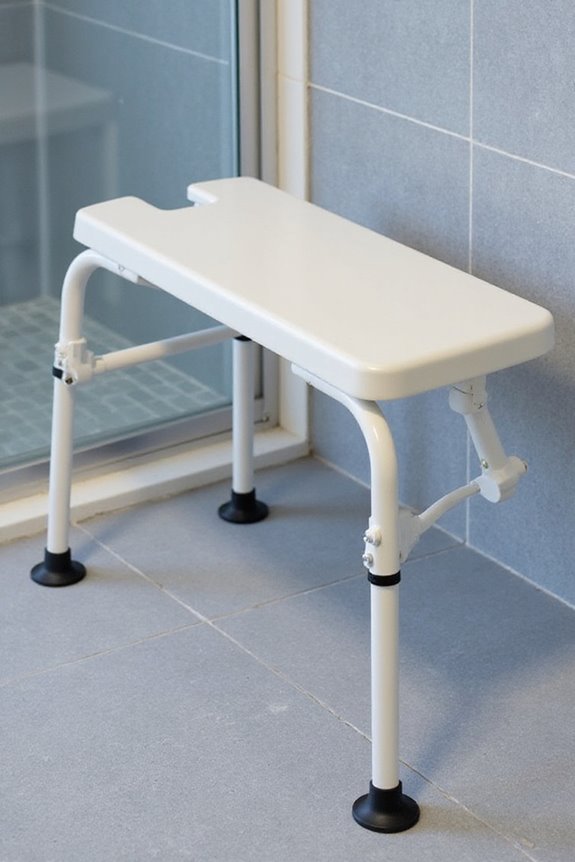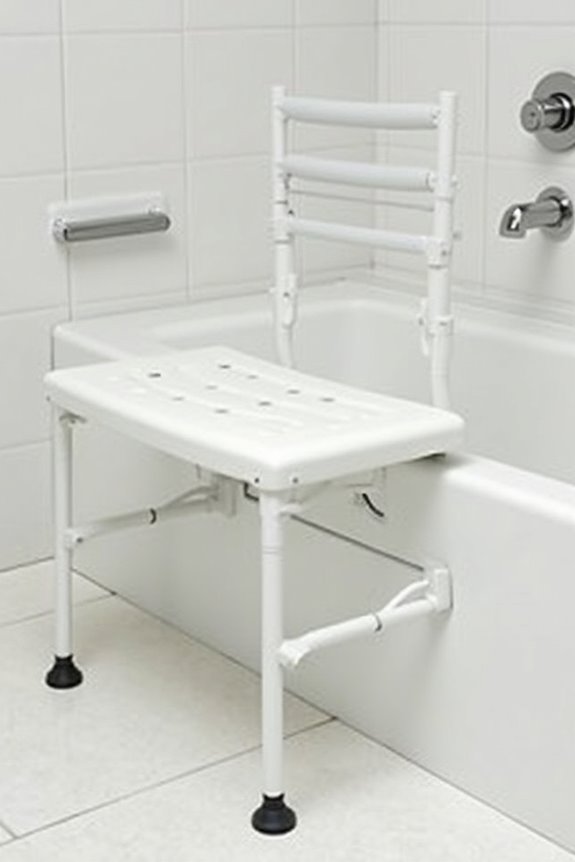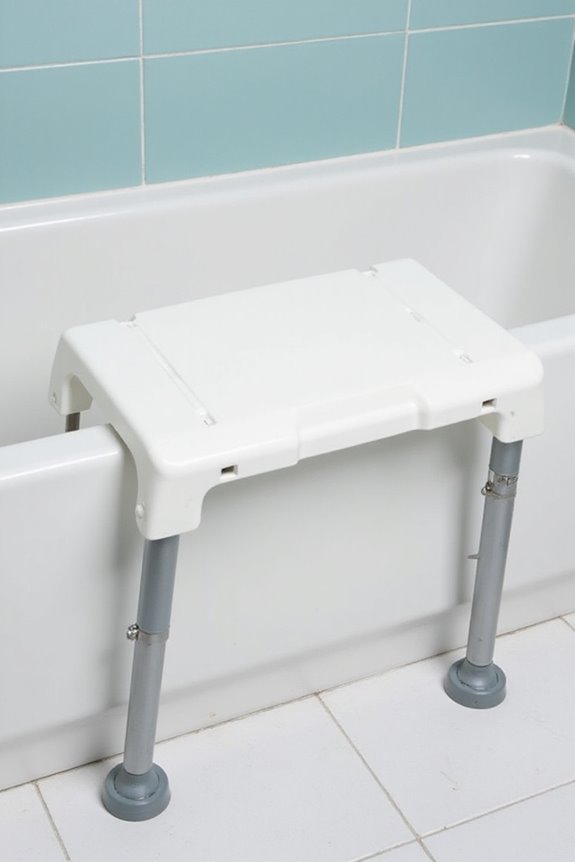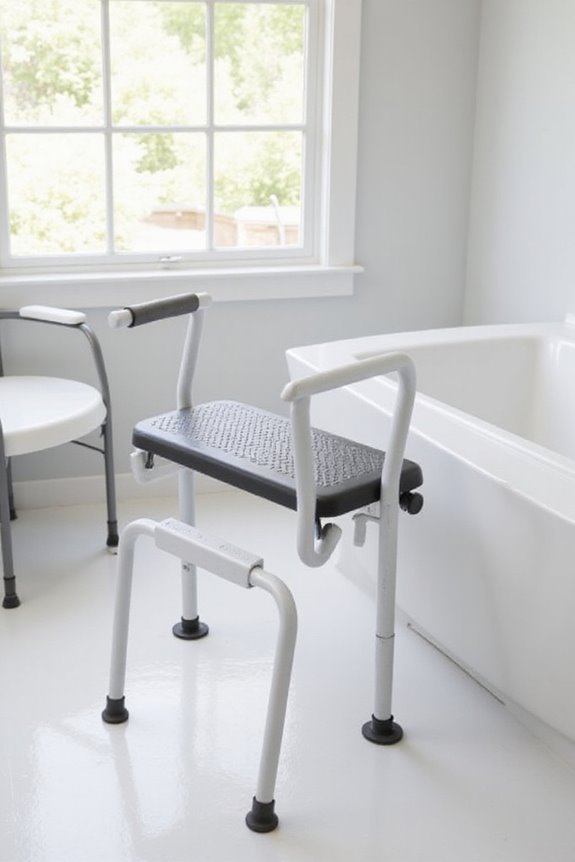A transfer bench is a specialized medical device for safe transfers during bathing. It minimizes the need for stepping over the tub wall, reducing slip and fall risks. Key features include adjustable height, non-skid feet, and support options like backrests. Various types exist, including standard, swivel, sliding, bariatric, and shower transfer benches, each catering to different user needs. This equipment enhances user independence and boosts safety. Additional details on usage and maintenance can be explored further.
Key Takeaways
- A transfer bench is a medical device designed to assist users in safely transferring into and out of bathtubs or showers.
- It reduces the need to step over the tub wall, minimizing the risk of slips and falls.
- Transfer benches come in various types, including standard, swivel, sliding, bariatric, and shower-specific designs.
- Key features include adjustable height, non-skid feet, and support options like backrests for enhanced safety and comfort.
- Using a transfer bench promotes user independence and reduces strain on caregivers during personal hygiene routines.
Definition and Purpose of Transfer Benches
A transfer bench is a specialized medical device designed to facilitate safe transfers for patients, particularly during bathing. This equipment features a transfer bench design that allows for seated movement, minimizing the need for individuals to step over the tub wall, thereby enhancing patient mobility.
Key purposes include:
- Safety Enhancement: Reduces the risk of slips and falls, especially for those with limited mobility.
- Support Features: Often includes backrests and armrests for added stability.
- Adjustability: Many models are height-adjustable and reversible, accommodating various bathroom configurations.
- User Independence: Enables self-transfer, promoting confidence in personal care routines. Additionally, high weight capacity in transfer benches enhances stability, further reducing the risk of accidents during use.
Types of Transfer Benches

Transfer benches are categorized into several distinct types, each designed to meet specific user needs and facilitate safe transfers during bathing.
- Standard Benches: These basic models offer stability with four legs and adjustable height, ensuring safety during transfers.
- Swivel Benches: Featuring a rotating seat, these benches assist users in pivoting their legs over the tub edge, ideal for those with limited lateral mobility.
- Sliding Benches: Equipped with a sliding seat mechanism, they enable horizontal movement into the tub or shower, minimizing lifting.
- Bariatric Benches: Designed for heavier users, these models support weights of 400 to 500 pounds, ensuring enhanced stability and comfort.
- Shower Transfer Benches: Extending beyond the shower edge, they assist with step-in difficulties, often featuring padded seats for added comfort.
Key Features of Transfer Benches

Key features of transfer benches greatly enhance user safety and comfort during bathing.
Adjustable Height
- Legs adjust to accommodate different user heights, typically ranging from 17″ to 23″.
- Seat dimensions are around 25″ wide and 16″-17.5″ deep for stability.
Safety Features
- Non-skid feet prevent slipping on wet surfaces, while wide-based legs enhance sturdiness.
- Secure locking mechanisms on adjustable parts guarantee stability during use.
- Many models support users weighing up to 300 lbs or more.
Support Options
- Some benches include removable or fixed backrests for added comfort.
- Ergonomic design reduces fatigue, improving user posture while bathing.
These features collectively guarantee a safer and more comfortable bathing experience for individuals.
Benefits of Using Transfer Benches

The benefits of using transfer benches are significant, particularly for individuals with reduced mobility or those requiring assistance during bathing.
User Independence Support
- Transfer benches enable users to maintain personal hygiene independently, reducing the need for full assistance.
- They facilitate seated washing, which alleviates joint stress, enhancing comfort.
Safety Enhancement
- These benches minimize slip and fall risks by providing a stable transfer surface, promoting user safety during tub entry and exit.
- Proper installation and use are essential for preventing bathroom injuries, common among elderly or disabled individuals.
Caregiver Burden Reduction
– Transfer benches lessen caregiver strain by allowing safer, smoother transfers, focusing assistance on hygiene rather than physical support.
Incorporating transfer benches into bathing routines fosters dignity, autonomy, and safety for both users and caregivers. Additionally, they are often designed with non-slip surfaces to further enhance safety during use.
Comparison With Other Bathing Equipment

Comparing transfer benches with other bathing equipment reveals distinct advantages and limitations that cater to varying user needs.
Transfer Bench Advantages:
- Extends over the tub edge, facilitating easier entry without stepping over the wall.
- Typically includes armrests or handles for added stability.
- Accommodates individuals who cannot safely stand while bathing.
Transfer Bench Drawbacks:
- Commonly leads to water spillage outside the tub.
- Offers a single-function solution compared to more inclusive full bathroom transfer systems.
- Requires sliding or lifting, posing a risk of slips during transfers.
In contrast, sliding transfer benches provide features like seat belts and enhanced caregiver assistance. Portable bath seats, while lightweight, generally lack the stability and weight capacity of transfer benches, making them less suitable for users with significant mobility challenges.
Proper Usage and Assembly
Assembly Tips
- Verify all parts are included before assembly.
- Lay the bench upside down; attach legs by matching markings.
- Securely lock legs with push pins and turn the bench right-side up.
- Install the backrest and armrests, guaranteeing stability and firm attachment.
Usage Guidelines
- Position the bench across the bathtub edge, stabilizing suction cups and legs.
- Use the bench to transfer safely, utilizing backrest and armrests.
- Guarantee the bench is dry before use to prevent slips.
- Adhere to the manufacturer’s weight capacity to avoid injury.
- Inspect the bench regularly for wear or instability, and consider using grab bars for safety to enhance support during transfers.
Maintenance and Cleaning
Regular maintenance and cleaning of a transfer bench are essential for ensuring its longevity and safe operation. Adopting effective cleaning techniques and maintenance tips can enhance hygiene and functionality.
- Wipe down surfaces after each use to eliminate soap scum and mineral deposits.
- Use mild detergent and warm water for regular cleaning; avoid bleach and abrasives.
- Dry thoroughly to prevent mold growth.
Inspect hard-to-reach areas periodically for dirt accumulation.
- Employ soft cloths and brushes for delicate components.
- Lubricate sliding rails with WD-40 after cleaning.
Store the bench in a dry, ventilated space, away from direct sunlight to prevent material degradation.
Routine checks for wear and tear, along with accessible cleaning supplies, contribute to ideal performance and safety.
Portability and Adaptability
Key aspects include:
- Tool-free assembly: Enables quick setup and disassembly, facilitating easy travel and storage.
- Adjustable features: Seat heights can range from 16.5″ to 24″, accommodating various user needs and bathing surfaces.
- Compact designs: Folding frames and modular components enhance portability, fitting into small spaces and carrying cases compliant with FAA regulations.
These features guarantee that transfer benches provide a safe, stable aid for patient transfers while remaining convenient and user-friendly.
Frequently Asked Questions
How Much Weight Can a Typical Transfer Bench Support?
Typical transfer benches exhibit weight capacities ranging from 300 to 500 pounds, ensuring user safety through robust materials and construction. These benches accommodate various needs, fostering confidence and security for individuals during transfers in challenging environments.
Are Transfer Benches Covered by Insurance or Medicare?
Approximately 65 million Americans rely on Medicare benefits for durable medical equipment. Transfer benches may be covered under insurance coverage if deemed medically necessary, requiring proper documentation from healthcare providers to guarantee approval for reimbursement.
Can Transfer Benches Be Used Outdoors?
The use of transfer benches outdoors presents challenges due to safety features designed for indoor use and the vulnerability of outdoor materials. Stability and durability may compromise safety, necessitating alternatives specifically crafted for outdoor environments.
How Do I Choose the Right Size Transfer Bench?
Choosing the right size transfer bench involves evaluating transfer bench features, such as width and height, alongside selecting durable transfer bench materials. Proper measurements guarantee comfort and safety, fostering a secure and welcoming bathroom environment for users.
What Is the Average Cost of a Transfer Bench?
The average cost of a transfer bench ranges from $50 to $200, influenced by features like adjustable height and materials such as aluminum or heavy-duty steel, appealing to those seeking both affordability and quality in their purchases.



